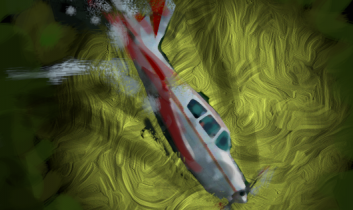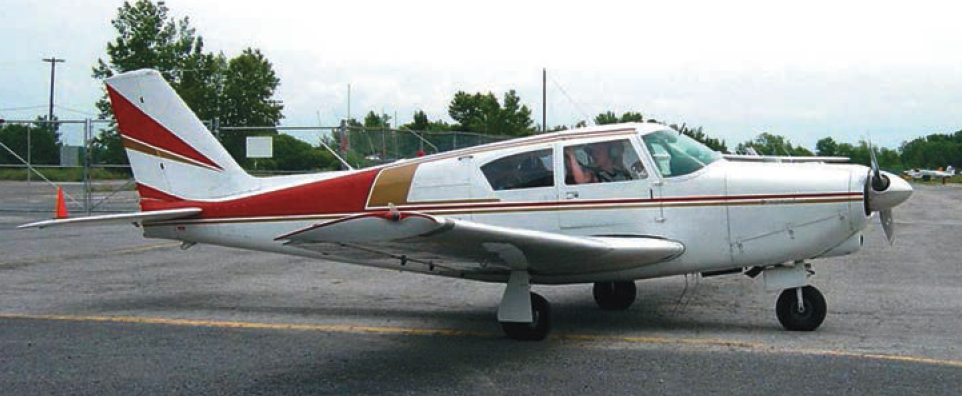Piper Crash at Cape Cod Bay
Piper Crash at Cape Cod Bay ( PA-24-180 )
On January 15, 2012, about 1005 Eastern Standard Time, a Piper PA-24-180 crashed into Cape Cod Bay near Brewster, Massachusetts. The airplane was registered to a private individual and was operated by a private pilot. Instrument meteorological conditions prevailed at the time and an instrument flight rules flight plan was filed for the instructional flight from Vineyard Haven, Massachusetts (MVY) to Hyannis, Massachusetts (HYA). The airplane was substantially damaged. The private pilot and a flight instructor were fatally injured.
The pilot filed a flight plan and obtained a weather briefing through the Direct User Access Terminal System (DUATS) at 1459 on January 14, 2012, the day prior to the accident. According to his wife, the pilot was practicing instrument procedures as part of an instrument proficiency check. After performing two practice approaches, the pilot requested four turns in holding at MECEJ holding fix.
After the pilot reported that he was established in the holding pattern at MEJEC, at 1504:01, the controller queried the pilot on his altitude control, stating that the aircraft altitude was varying by 500 feet. The controller asked the pilot if he needed assistance and at 1504:09 the pilot replied, “There’s smoke in the cabin.”
At 1504:24, the pilot stated, “We’ve got to clear the smoke and uh…” At 1504:33, the last transmission was received from the pilot, “Four eight pop I guess we’ll sit… we’ll stay in the uh… we’ve cleared the smoke we’ll stay in the uh…” Radar and radio contact was subsequently lost. The pilot’s wife listened to the recorded ATC voice communications after the accident and reported that the voices from the aircraft related to smoke in the cabin were that of her husband, the pilot. Recorded radar data indicated that at 1504:05 the aircraft was proceeding in a westerly direction at 2,200 feet above mean sea level (msl). The last radar return at 1504:45 indicated that the airplane had commenced a right turn and had descended to 1,300 feet msl. The wreckage was located about 0.3 nautical miles southeast of the last radar return.
The pilot held a private pilot certificate with ratings for airplane single-engine land and instrument airplane. On an insurance application dated January 9, 2012, he reported 676 hours total time, including 111 in the PA-24. His latest document flight review occurred on October 22, 2011.
The flight instructor held a commercial pilot certificate with ratings for airplane single-engine land, airplane multiengine land, airplane single-engine sea, instrument airplane, ground instructor, and flight instructor (airplane single-engine and multiengine, instrument airplane). He reported 7,384 hours of total flight experience on his latest Federal Aviation Administration (FAA) second-class medical certificate, dated March 30, 2011.
The airplane was a single-engine, low wing, retractable gear airplane, powered by a Lycoming O-360-A1D engine rated
at 180 horsepower at 2,700 rpm. The tachometer time observed in the wreckage was 5,049.3 hours. It was equipped with an electrically heated pitot tube, but not equipped with ice protection on the wings, stabilator, or vertical stabilizer, nor was it certificated for flight in icing conditions.
According to the aircraft maintenance records, the last recorded maintenance on the airplane occurred on December 16, 2011, at tach time 5,032.1 hours. The following entry was noted: “Checked for inoperative charging system, alternator circuit breaker found tripped, checked all alternator wiring from firewall forward, found that a 50-amp alternator circuit installed did not match 60-amp breaker called for in InterAv wiring diagram, 50-amp breaker previously approved by FAA form 337 dated 1/20/03, checked alternator brushes, adjusted alternator belt tension, ran engine several times and found charging system working properly, could not duplicate circuit breaker tripping. Replaced both wing tip navigation lamps P/N A7512-12.”
The 50-amp circuit breaker was not replaced during the maintenance on December 16. The last annual inspection on the airplane occurred on July 2, 2011, at tach time 4,983.9 hours. On June 11, 2008, during an annual inspection, the master circuit breaker was removed and replaced with another 50-amp circuit breaker.
The pilot’s wife reported the following maintenance discrepancies during an interview following the accident. In November, 2011, the landing gear would not extend and the alternate extension system was required to lower the gear. On January 4, 2012, the voltmeter and ammeter were discharging. She stated that the airplane flew several times after that with no issues. There were no aircraft logbook entries to document the events.
According to the FAA, on December 27, 2011, the pilot was involved in an ATC deviation, and the pilot cited radio problems in his explanation of the event. ATC reported that the pilot did not respond to radio calls and deviated from his last assigned heading and altitude. The aircraft logbook did not include an entry related to a radio repair for the flight of December 27.
The wreckage was found submerged in Cape Cod Bay, at coordinates 41 46.600 north, 70 06.996 west. Once recovered, the wreckage was sent to a storage facility at Clayton, Delaware for examination, which did not reveal evidence of in-flight or post-crash fire and no soot was seen on the wreckage. The forward cabin section contained the instrument panel area, control wheels, rudder pedals, avionics and engine controls. The firewall was present and exhibited impact damage. The engine mount was attached to the firewall and the engine was attached to the mount. Side skins and top and bottom skins were missing, as were all window enclosures.
The rudder pedals were in place and the control cables were attached. The engine controls were impact-damaged and could not be moved. The pilot’s control wheel was not present and the co-pilot’s control wheel exhibited impact damage. Both rudder and stabilator trim controls and primary controls were impact-damaged and could not be operated. The cables were traced aft to their separation points. All breaks in the cables showed evidence of overstress or cuts by recovery personnel. The pilot and co-pilot seats were not located.
The primary electrical harness was in place. The circuit breakers were impact-damaged and separated from their mountings in the circuit breaker panel. Several electrical switches were impact-damaged. The pitot heat switch was found in the “on” position, as was the alternate pitot/static air source selector switch. The electrical harness was examined for pre-impact wiring integrity, as were various associated components. All panel-mounted avionics were impact-damaged. The aircraft’s primary battery was not recovered. Several electrical and avionics components were removed for examination at the NTSB Materials Laboratory.
The center section of the fuselage had the left inboard wing root section attached. All top, bottom and side skins were breached. Two sets of seat belts were attached to the floor and side wall. One set had the shoulder restraint belt attached to the lap belt. The aft bench seat was located, but was not attached to the structure. The fuel valve was located and noted to be on the “right tank” position. The flap control lever was located and was impact-damaged.
The vertical fin was attached to the fuselage and exhibited leading edge impact damage and skin separation at its root areas. The rudder was attached to the vertical fin at its hinge points. It exhibited impact damage and breaching of the skins. The balance weight was not located. Control continuity was traced forward to the aft cabin area separations, then to the forward cabin area separations. All separations exhibited overload signatures or were cut by recovery personnel.
The left wing root section was attached to the fuselage. The main landing gear was damaged from impact and found in the up (retracted) position. The outboard section was breached and exhibited accordion type aft crushing of the leading edge. The fuel tank was not recovered. The upper spar cap was partially separated and bent upward approximately 45 degrees. The left aileron and its balance weight were separated. The weight was located. Aileron control continuity was established to its bellcrank. The aileron control cables were found in the instrument panel area and offered limited movement due to impact damage. The flap was segmented and partially attached.
The right wing was segmented and separated from the fuselage and had leading edge, accordion-type crushing aft. The wing skin was breached at the main fuel tank to inboard sections. The fuel tank was not recovered. The landing gear was attached and was in the up (retracted) position, with impact damage noted. The aileron was partially attached to its hinges and was bent from impact damage. Control cable continuity was established to the aileron bellcrank and then to cable separations. All separations exhibited overload signatures or were cut by recovery personnel. The propeller hub was fractured and about 60 percent was missing. The propeller blades were not recovered.
On his most recent FAA third class medical certificate application of December 9, 2010, the pilot reported the following medications: lovastatin, which is a cholesterol-lowering medication used to treat elevated lipids, allopurinol, which is used to treat gout, and vitamins. The FAA Bioaeronautical Sciences Research Laboratory (CAMI), Oklahoma City, Oklahoma, performed forensic toxicology testing pilot during which the following drugs were detected in the pilot’s liver and blood: diazepam, nordiazepam in blood, tramadol and warfarin. Diazepam has sedative, muscle-relaxant and amnestic effects used to treat anxiety disorders, alcohol withdrawal, and muscle spasm. Nordiazepam is used as a treatment for anxiety. Tramadol is a prescription medication that is a centrally acting sedating narcotic analgesic. The makers of this drug warn it may impair mental and/or physical ability required for the performance of potentially hazardous tasks (e.g. driving and operating heavy machinery). Warfarin is a prescription anticoagulant used to treat patients with deep vein thrombosis, pulmonary embolus, and atrial fibrillation.
A postmortem examination of the pilot noted the cause of death as severe multiple injuries and the manner of death was “accident (plane crash).” Following the wreckage examination of February 28, 2012, there was no evidence of overheating or fire on any of the examined components.
About The Author
For more information, in the U.S.A. (N.T.S.B.) The NTSB is an independent Federal agency charged by Congress with investigating every civil aviation accident in the U.S. and significant accidents in other modes of transportation-railroad, highway, marine and pipeline. WEBSITE = http://www.ntsb.gov/ For more information, in CANADA (T.S.B.) The Transportation Safety Board of Canada (TSB) is an independent agency that advances transportation safety by investigating occurrences in the marine, pipeline, rail and air modes of transportation. WEBSITE = http://www.tsb.gc.ca/eng/
View all articles by N.T.S.B..
















































